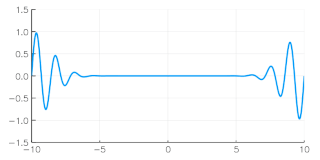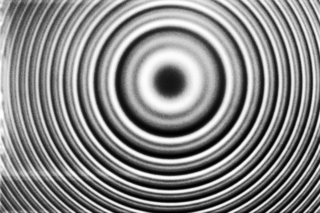Absence of nodes in one dimension
In one dimension, the ground state of the Schrödinger equation can be proven to have no nodes. [1]
Derivation
Consider the average energy of a state with a node at x = 0; i.e., ψ(0) = 0. The average energy in this state would be

where V(x) is the potential.
With integration by parts:

Hence in case that  is equal to zero, one gets:
is equal to zero, one gets:

Now, consider a small interval around  ; i.e.,
; i.e.,  . Take a new (deformed) wave function ψ'(x) to be defined as
. Take a new (deformed) wave function ψ'(x) to be defined as  , for
, for  ; and
; and  , for
, for  ; and constant for
; and constant for  . If
. If  is small enough, this is always possible to do, so that ψ'(x) is continuous.
is small enough, this is always possible to do, so that ψ'(x) is continuous.
Assuming  around
around  , one may write
, one may write

where  is the norm.
is the norm.
Note that the kinetic-energy densities hold  everywhere because of the normalization. More significantly, the average kinetic energy is lowered by
everywhere because of the normalization. More significantly, the average kinetic energy is lowered by  by the deformation to ψ'.
by the deformation to ψ'.
Now, consider the potential energy. For definiteness, let us choose  . Then it is clear that, outside the interval
. Then it is clear that, outside the interval  , the potential energy density is smaller for the ψ' because
, the potential energy density is smaller for the ψ' because  there.
there.
On the other hand, in the interval  we have
we have

which holds to order  .
.
However, the contribution to the potential energy from this region for the state ψ with a node is

lower, but still of the same lower order  as for the deformed state ψ', and subdominant to the lowering of the average kinetic energy. Therefore, the potential energy is unchanged up to order
as for the deformed state ψ', and subdominant to the lowering of the average kinetic energy. Therefore, the potential energy is unchanged up to order  , if we deform the state
, if we deform the state  with a node into a state ψ' without a node, and the change can be ignored.
with a node into a state ψ' without a node, and the change can be ignored.
We can therefore remove all nodes and reduce the energy by  , which implies that ψ' cannot be the ground state. Thus the ground-state wave function cannot have a node. This completes the proof. (The average energy may then be further lowered by eliminating undulations, to the variational absolute minimum.)
, which implies that ψ' cannot be the ground state. Thus the ground-state wave function cannot have a node. This completes the proof. (The average energy may then be further lowered by eliminating undulations, to the variational absolute minimum.)
Implication
As the ground state has no nodes it is spatially non-degenerate, i.e. there are no two stationary quantum states with the energy eigenvalue of the ground state (let's name it  ) and the same spin state and therefore would only differ in their position-space wave functions. [1]
) and the same spin state and therefore would only differ in their position-space wave functions. [1]
The reasoning goes by contradiction: For if the ground state would be degenerate then there would be two orthonormal [2] stationary states  and
and  — later on represented by their complex-valued position-space wave functions
— later on represented by their complex-valued position-space wave functions  and
and  — and any superposition
— and any superposition  with the complex numbers
with the complex numbers  fulfilling the condition
fulfilling the condition  would also be a be such a state, i.e. would have the same energy-eigenvalue
would also be a be such a state, i.e. would have the same energy-eigenvalue  and the same spin-state.
and the same spin-state.
Now let  be some random point (where both wave functions are defined) and set:
be some random point (where both wave functions are defined) and set:

and

with

(according to the premise no nodes).
Therefore, the position-space wave function of  is
is

Hence

for all  .
.
But  i.e.,
i.e.,  is a node of the ground state wave function and that is in contradiction to the premise that this wave function cannot have a node.
is a node of the ground state wave function and that is in contradiction to the premise that this wave function cannot have a node.
Note that the ground state could be degenerate because of different spin states like  and
and  while having the same position-space wave function: Any superposition of these states would create a mixed spin state but leave the spatial part (as a common factor of both) unaltered.
while having the same position-space wave function: Any superposition of these states would create a mixed spin state but leave the spatial part (as a common factor of both) unaltered.
In quantum mechanics, the Hamiltonian of a system is an operator corresponding to the total energy of that system, including both kinetic energy and potential energy. Its spectrum, the system's energy spectrum or its set of energy eigenvalues, is the set of possible outcomes obtainable from a measurement of the system's total energy. Due to its close relation to the energy spectrum and time-evolution of a system, it is of fundamental importance in most formulations of quantum theory.

The uncertainty principle, also known as Heisenberg's indeterminacy principle, is a fundamental concept in quantum mechanics. It states that there is a limit to the precision with which certain pairs of physical properties, such as position and momentum, can be simultaneously known. In other words, the more accurately one property is measured, the less accurately the other property can be known.

The quantum harmonic oscillator is the quantum-mechanical analog of the classical harmonic oscillator. Because an arbitrary smooth potential can usually be approximated as a harmonic potential at the vicinity of a stable equilibrium point, it is one of the most important model systems in quantum mechanics. Furthermore, it is one of the few quantum-mechanical systems for which an exact, analytical solution is known.

In quantum physics, a wave function is a mathematical description of the quantum state of an isolated quantum system. The most common symbols for a wave function are the Greek letters ψ and Ψ. Wave functions are complex-valued. For example, a wave function might assign a complex number to each point in a region of space. The Born rule provides the means to turn these complex probability amplitudes into actual probabilities. In one common form, it says that the squared modulus of a wave function that depends upon position is the probability density of measuring a particle as being at a given place. The integral of a wavefunction's squared modulus over all the system's degrees of freedom must be equal to 1, a condition called normalization. Since the wave function is complex-valued, only its relative phase and relative magnitude can be measured; its value does not, in isolation, tell anything about the magnitudes or directions of measurable observables. One has to apply quantum operators, whose eigenvalues correspond to sets of possible results of measurements, to the wave function ψ and calculate the statistical distributions for measurable quantities.
In physics, an operator is a function over a space of physical states onto another space of physical states. The simplest example of the utility of operators is the study of symmetry. Because of this, they are useful tools in classical mechanics. Operators are even more important in quantum mechanics, where they form an intrinsic part of the formulation of the theory.

In condensed matter physics, Bloch's theorem states that solutions to the Schrödinger equation in a periodic potential can be expressed as plane waves modulated by periodic functions. The theorem is named after the physicist Felix Bloch, who discovered the theorem in 1929. Mathematically, they are written

The path integral formulation is a description in quantum mechanics that generalizes the stationary action principle of classical mechanics. It replaces the classical notion of a single, unique classical trajectory for a system with a sum, or functional integral, over an infinity of quantum-mechanically possible trajectories to compute a quantum amplitude.

In physics, a wave packet is a short burst of localized wave action that travels as a unit, outlined by an envelope. A wave packet can be analyzed into, or can be synthesized from, a potentially-infinite set of component sinusoidal waves of different wavenumbers, with phases and amplitudes such that they interfere constructively only over a small region of space, and destructively elsewhere. Any signal of a limited width in time or space requires many frequency components around a center frequency within a bandwidth inversely proportional to that width; even a gaussian function is considered a wave packet because its Fourier transform is a "packet" of waves of frequencies clustered around a central frequency. Each component wave function, and hence the wave packet, are solutions of a wave equation. Depending on the wave equation, the wave packet's profile may remain constant or it may change (dispersion) while propagating.

In atomic physics, the fine structure describes the splitting of the spectral lines of atoms due to electron spin and relativistic corrections to the non-relativistic Schrödinger equation. It was first measured precisely for the hydrogen atom by Albert A. Michelson and Edward W. Morley in 1887, laying the basis for the theoretical treatment by Arnold Sommerfeld, introducing the fine-structure constant.
In physics, the S-matrix or scattering matrix relates the initial state and the final state of a physical system undergoing a scattering process. It is used in quantum mechanics, scattering theory and quantum field theory (QFT).
In mathematical physics, the WKB approximation or WKB method is a method for finding approximate solutions to linear differential equations with spatially varying coefficients. It is typically used for a semiclassical calculation in quantum mechanics in which the wavefunction is recast as an exponential function, semiclassically expanded, and then either the amplitude or the phase is taken to be changing slowly.
The adiabatic theorem is a concept in quantum mechanics. Its original form, due to Max Born and Vladimir Fock (1928), was stated as follows:
In quantum physics, Fermi's golden rule is a formula that describes the transition rate from one energy eigenstate of a quantum system to a group of energy eigenstates in a continuum, as a result of a weak perturbation. This transition rate is effectively independent of time and is proportional to the strength of the coupling between the initial and final states of the system as well as the density of states. It is also applicable when the final state is discrete, i.e. it is not part of a continuum, if there is some decoherence in the process, like relaxation or collision of the atoms, or like noise in the perturbation, in which case the density of states is replaced by the reciprocal of the decoherence bandwidth.

In quantum mechanics, a two-state system is a quantum system that can exist in any quantum superposition of two independent quantum states. The Hilbert space describing such a system is two-dimensional. Therefore, a complete basis spanning the space will consist of two independent states. Any two-state system can also be seen as a qubit.
In quantum mechanics, the momentum operator is the operator associated with the linear momentum. The momentum operator is, in the position representation, an example of a differential operator. For the case of one particle in one spatial dimension, the definition is:
In quantum mechanics the delta potential is a potential well mathematically described by the Dirac delta function - a generalized function. Qualitatively, it corresponds to a potential which is zero everywhere, except at a single point, where it takes an infinite value. This can be used to simulate situations where a particle is free to move in two regions of space with a barrier between the two regions. For example, an electron can move almost freely in a conducting material, but if two conducting surfaces are put close together, the interface between them acts as a barrier for the electron that can be approximated by a delta potential.
This article relates the Schrödinger equation with the path integral formulation of quantum mechanics using a simple nonrelativistic one-dimensional single-particle Hamiltonian composed of kinetic and potential energy.
In quantum mechanics, energy is defined in terms of the energy operator, acting on the wave function of the system as a consequence of time translation symmetry.
Coherent states have been introduced in a physical context, first as quasi-classical states in quantum mechanics, then as the backbone of quantum optics and they are described in that spirit in the article Coherent states. However, they have generated a huge variety of generalizations, which have led to a tremendous amount of literature in mathematical physics. In this article, we sketch the main directions of research on this line. For further details, we refer to several existing surveys.
In quantum mechanics, a translation operator is defined as an operator which shifts particles and fields by a certain amount in a certain direction. It is a special case of the shift operator from functional analysis.




















































